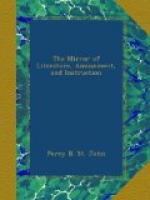“Scroops’ Inne,[2] sometime Sergeant’s Inne, was situate against the church of St. Andrew, in Oldborne, in the city of London, with two gardens.
“On the High-streete of Oldborne (says Stowe) have ye many fair houses builded, and lodgings for gentlemen, innes for travellers, and such like, up almost (for it lacketh but little) to St. Giles’s in the Fields.”
Gerard, the famous herbalist, lived in Holborn, and had there a large botanic garden. Holborn was then in the outskirts of the town on that side. Richard the Third asked the Bishop of Ely to send for some of the good strawberries which he heard the bishop had in his garden in Holborn.
“In 1417, Lower Holborn (says Brayley) one of the great inlets to the city, was first paved, it being then described as a highway, so deep and miry, that many perils and hazards were thereby occasioned; and the King, at his own expense, is recorded to have employed two vessels, each of twenty tons burthen, for bringing stones for that purpose.
“In 1534 an act was passed for paving with stone the street between Holborn Bridge and Holborn Bars, at the west end thereof, and also the streets of Southwark; and every person was made liable to maintain the pavement before his door, under the forfeiture of sixpence to the king for every square yard.”
On the south side of Holborn Hill was St. Andrew’s Church, of considerable antiquity; but rebuilt in a plain, neat manner. Here was buried Thomas Wriothesley, lord chancellor in the latter part of the life of Henry the Eighth: a fiery zealot, who (says Pennant) not content with seeing the amiable Anne Askew put to the torture, for no other crime than difference of faith, flung off his gown, degraded the chancellor into the bureau, and with his own hands gave force to the rack.
“Furnival’s Inn was one of the hosteries belonging to Lincoln’s Inn, in old times the town abode of the Lords of Furnivals.
“Thaive’s Inn was another, old as the time of Edward the Third. It took its name from John Tavye.
“Staples Inn; so called from its having been a staple in which the wool-merchants were used to assemble.
“Barnard’s Inn, originally Mackworth’s Inn, having been given by the executors of John Mackworth, dean of Lincoln, to the dean and chapter of Lincoln, on condition that they should find a pious priest to perform divine service in the cathedral of Lincoln—in which John Mackworth lies interred.
“Hatton Garden was the town house and gardens of the Lord Hatton, founded by Sir Christopher Hatton, lord-keeper in the reign of Queen Elizabeth. The place he built his house on was the orchard and garden belonging to Ely House.
“Brook House was the residence of Sir Fulke Greville, Lord Brooke.
“Southampton Buildings, built on the site of Southampton House, the mansion of the Wriothesleys, earls of Southampton. When Lord Russel passed by this house, on his way to execution, he felt a momentary bitterness of death, in recollecting the happy moments of the place. He looked (says Pennant) towards Southampton House, the tear started into his eye, but he instantly wiped it away.




